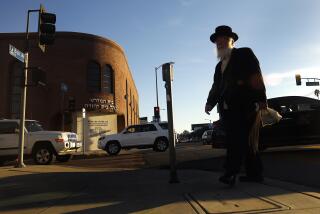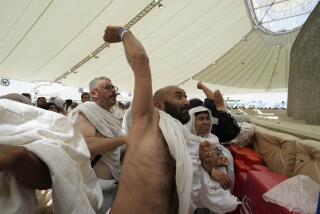Ramadan Comes to an End Today
- Share via
Following the advice of astronomers rather than relying on the traditional sighting of the new moon, most large Southland mosques will end the Islamic fasting month of Ramadan in mass prayer gatherings today, breaking with Muslim custom by observing a date determined weeks before.
While the science-versus-religion issue is not new to Islam, this was the first time that leaders of the largest mosques in Los Angeles and Orange counties had established the start and end of Ramadan based on the predicted position of the moon and sun.
The sayings of the Prophet Mohammed, who founded Islam in 622, direct that the Ramadan month of daytime fasting should begin and end after the slim crescent of the new moon can be seen. So Muslims traditionally leave open two possible dates and wait to see the moon.
Muslim astronomers say, however, that “sightings” have often occurred when they were scientifically impossible.
A committee of eight American Muslim scientists and engineers declared in early January that the possibility was “zero” of seeing the new crescent moon on Wednesday night anywhere in the contiguous United States and Canada or anywhere east of North America. That established Thursday night as the new moon and Friday as the first day of the three-day Eid al-Fitr celebration of the end of Ramadan.
And Islamic leaders at 15 Southern California centers said in a statement issued Jan. 26 that they will work toward “formulation of an Islamic calendar for years to come,” establishing dates by calculating the highly-predictable movements of the moon instead of relying on actually seeing it.
Some Muslims are unhappy with the change, noting that some followers of Islam in the Middle East reported seeing the lunar crescent Wednesday night and began the three-day Eid al-Fitr with Thursday morning prayers.
Indeed, Islamic groups in West Los Angeles and Anaheim, relying on those overseas reports, also began celebrating the holiday Thursday.
“What they are doing is unacceptable,” said Majdi Ataya, a spokesman for the Islamic Center of Anaheim about the calendar-setting group, of which he is critical.
“They are contradicting the rules of the religion. Not only that, the sightings Wednesday night were confirmed in Algeria and the United Arab Emirates.”
The controversy was complicated by an article in the March issue of Sky and Telescope magazine saying that it would indeed be possible to sight the sliver of the new moon Wednesday night in California.
But Muslim astronomical committee member Sameer Etman, an engineer with Los Angeles County, said Jet Propulsion Laboratory astronomer Ahmed Salama, a Muslim, and others on the committee reviewed “an extensive presentation” in making their judgment. Etman said that he believes the amateur astronomy magazine “didn’t consider all the parameters.”
Although the Islamic Center of Southern California, which expected about 10,000 for Eid prayers this morning at the Los Angeles Convention Center, has followed astronomical calculations since 1984, the change this year was a departure for centers like those in Northridge, Garden Grove, and the San Gabriel Valley.
“There will be critical articles coming out,” said Muzzamil Siddiqi, religious director of the Islamic Society of Orange County. Siddiqi, who backed the calendar-setting agreement, said he expected at least 8,000 Muslims to attend Eid prayers today at Mile Park Square in Fountain Valley.
The advantage of having a date for Eid al-Fitr known weeks in advance, Siddiqi said, is that Muslim workers and school children could ask for the day off in a timely fashion.
Organized Islam in America is leaning toward using the scientific calculations, said Nihad Owad, executive director of the Council on American-Islamic Relations in Washington, D.C.
Most Islamic centers already use astronomical projections to set dates for religious observances, Owad said.
Technically speaking, representatives who signed the agreement said only that the crescent moon would not be visible on Jan. 30 and March 1, but by doing so the mosque leaders could then announce that the first fasting day would be Feb. 2 and the last would be March 2.
“I feel uncomfortable with it because of our tradition,” said Jan Muhammad Diwan, the imam, or religious leader, of the Islamic Center of Northridge, which expects nearly 3,000 at prayers today on the Cal State Northridge campus. But Masood Rana, president of the Northridge center, agreed with the calendar-setting group and Diwan said he wanted to comply with the group decision.
Islam is not anti-science despite the debate over whether to rely on science or religious tradition, said UCLA historian Michael Morony, a specialist in Islamic history who is not Muslim himself.
“The Islamic world has had a highly developed astronomical and mathematical tradition since at least the 8th Century,” Morony said. Besides the traditions surrounding Mohammed’s words on the subject, the historian said, two other factors feed the resistance to using astronomical calculations.
“Muslims have a historical opposition to astrology--the idea that the movement of the planets and moon is linked to one’s fate--and, at least in the popular mind, astrology has been associated with astronomy,” Morony said.
The other element is simply “over who gets to say what--the scientists or the religious authorities,” Morony said. “I can understand that in Southern California, with people coming from so many different countries, there is a desire to make things less confusing and be more unified.”
Ahmed El-Gabalawy, who will give the Eid sermon today at Cal State Northridge, said the preset date made his job arranging for the large gathering easier this year.
“People complained a lot when the Islamic Center of Southern California started doing it in the 1980s, but they got used to it after a while,” El-Gabalawy said.
(BEGIN TEXT OF INFOBOX / INFOGRAPHIC)
Questionable Moon
With the end of the Ramadan period hanging on it, U.S. Muslim astronomers said chances wer “zero” anyone could see the new moon looking west at nightfall Wednesday. Muslims overseas and an American astronomy magazine disagreed.
More to Read
Sign up for Essential California
The most important California stories and recommendations in your inbox every morning.
You may occasionally receive promotional content from the Los Angeles Times.













